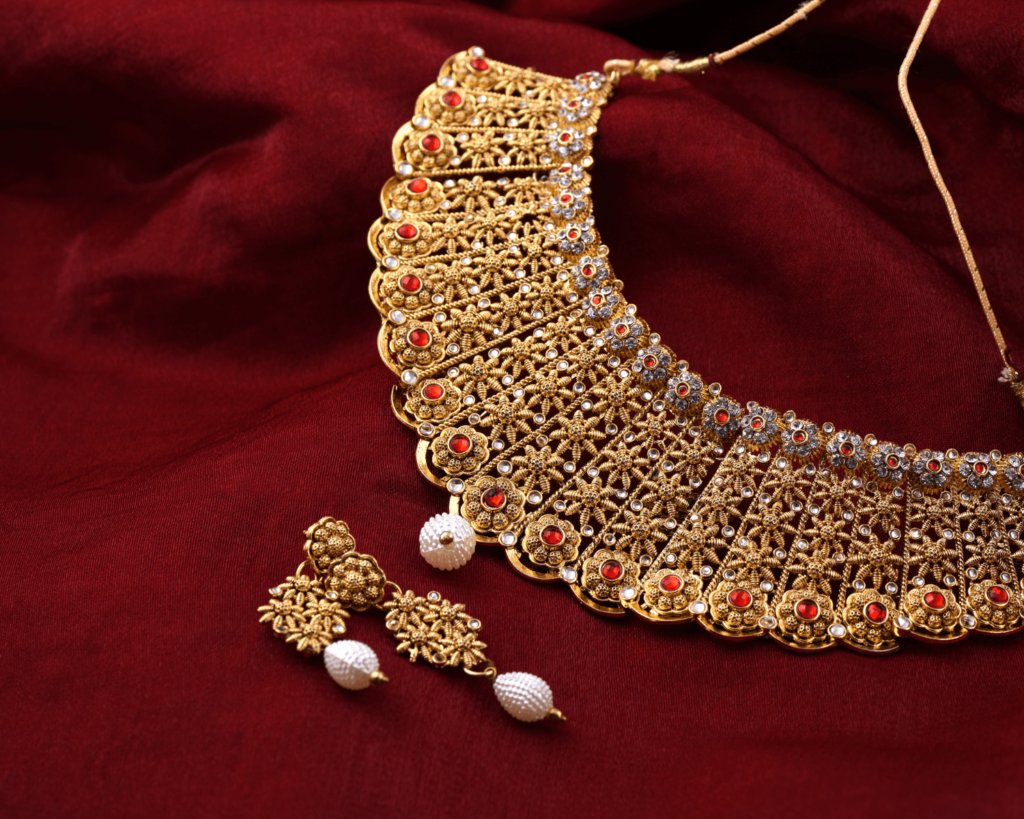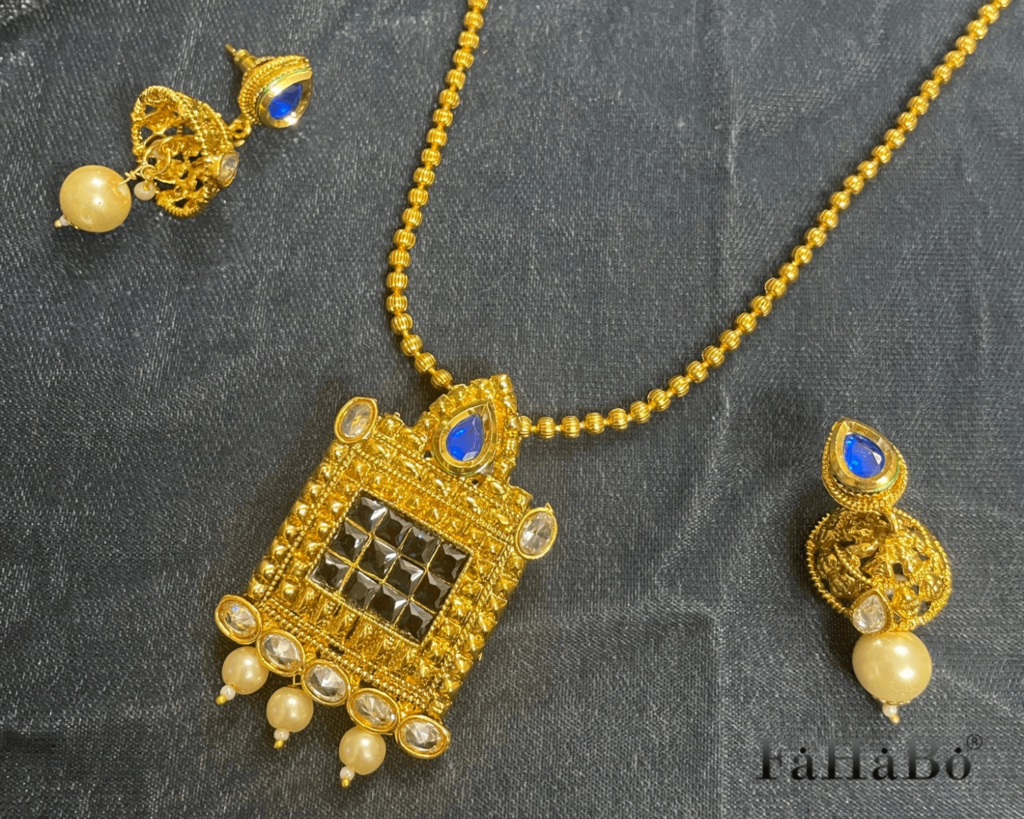Table of Contents
Introduction
Artificial gold plated jewellery has always been most loved jewellery Gold has always had a special charm in the beautiful world of jewellery. As a marketing expert with a good sense of artificial gold-plated jewellery, I’m here to clear up the confusion about 18k gold-plated, 22k gold-plated, gold-plated, and gold-plated jewellery. We’ll also talk about whether or not these beautiful products need to be certified or marked.

Artificial gold plated jewellery: Affordably Beautiful
General terms for gold-plated jewelry include both 18k and 22k types. Putting a tiny layer of gold on a base metal is what they have in common. This method makes it possible to make beautiful pieces that look like real gold but are much cheaper, so they can fit a wide range of tastes and budgets.
18k gold-plated jewelry adds a touch of class to artificial gold plated jewellery
“18k” stands for “18 karats,” which is the amount of pure gold in the mixture. For 18k gold-plated jewelry, a thin layer of 18k gold is electroplated onto a base metal. This gives the jewelry a fancy look without the high price. This method is popular with people who want to look classy without spending a lot of money because it is both long-lasting and cheap.
22k gold-plated jewelry adds richness in detail to artificial gold plated jewellery
22k gold-plated jewelry has more gold in it than 14k and 18k gold-plated jewelry. This gives the surface a deeper, more shiny look that is very close to the luxury of pure gold. Individuals who like luxury will be drawn to 22k gold-plated items because they have detailed details and a bright appearance.
Gold polish: bringing out the shine to artificial gold plated jewellery
Gold polish is something that is put on jewelry to make it shine and look better. Gold polish is different from gold plating, which adds a layer of gold to the metal. Gold polish is used to make the surface smoother. It’s a great way to make gold jewelry look new again and make sure it stays shiny over time.
Certification and Hallmarking: Ensuring Quality of Artificial gold plated jewellery

As someone who works in marketing, I know how important trust is in the jewellery world. Some gold-plated jewelry doesn’t need to be certified or hallmarked, but many trustworthy names do so to reassure customers of the quality. Certification makes it clear how much gold is in the piece and how well it was made, which gives buyers trust and raises the value of the item.
Ultimately, the choice between 18k and 22k gold-plated jewelry, gold-polish, and gold-plated pieces comes down to personal taste and cash. Whether you choose the affordable beauty of 18k gold plating or the luxurious beauty of 22k gold plating, knowing these details gives each beautiful piece more meaning.
Identifying the Plating of Artificial gold plated jewellery
For the average person, figuring out what kind of gold is on a piece of jewelry might seem hard at first. But with a few easy tips, you can solve the puzzle. Here is a guide that will help you figure out what kind of finishing your jewelry has without having to know a lot about it:
1. Consistency in color:
Gold Plated (18k/22k): The piece should have the same color of gold all over it. Gold-plated jewelry usually has a uniform color that makes it look like real gold.
Gold Polish: If the jewelry has a bright, shiny finish but isn’t a certain color of gold, it may be gold-polished instead of gold-plated.
2. Scratch Test:
Gold Plated (18k/22k): Scratch lightly in a place that won’t be seen. It’s probably gold-plated if you can see through to the main metal. Silver jewelry has a thin layer of gold that can wear off over time.
Gold Polish: If you scratch something, you might see the metal underneath, which means the surface is gold-polished instead of plated.
3. Magnet Test:
Gold Plated (18k/22k) and Gold Polish: Since gold isn’t magnetic, jewelry that sticks to a magnet probably isn’t made of real gold. This test helps rule out solid gold, but it can’t tell the difference between polish and plating.
4. Hallmarks and Stamps:
Gold-plated (18k/22k): Check the jewelry for marks like “18k” or “22k” that mean it is gold-plated (18k/22k). Keep in mind, though, that these stamps aren’t on all gold-plated items.
Gold Polish: Gold-polished items usually don’t have karat marks because they don’t have a thick layer of gold.
5. Tarnish and Wear:
Gold Plated (18k/22k): Some gold-plated jewelry may show signs of wear over time, making the base metal stand out more. There may also be tarnishing or staining.
Gold Polish: Because gold polish is only put on the surface, signs of wear might be a dulling or loss of shine instead of showing a different metal underneath.
6. Price and Weight:
Gold Plated (18k/22k): Look at how much the jewelry costs and how much it weighs. Things made of solid gold are much heavy and cost a lot more than things that are plated with gold. It’s probably gold-plated if the price for a heavy item seems too good to be true.
Gold Polish: Jewelry that is gold-polished is often less expensive than jewelry that is made of solid gold, but it might not be as light as jewelry that is gold-plated.
Remember that these ways can give you some information, but they aren’t foolproof. To get an accurate answer about what your jewellery is made of, you should talk to a trained jeweller or use special testing tools.
Standards to Sell Artificial gold plated jewellery

In India, there are rules and standards about selling gold jewellery, including gold-plated and gold-polished items. These are in place to protect consumers and keep the market honest. Here are some important rules and things to think about:
1. BIS Certification:
The Bureau of Indian Standards (BIS) is a government agency in India that makes sure the quality of things sold there. It is best for gold jewelry to have BIS approval, no matter if it is solid gold, gold-plated, or gold-polished. This certificate makes sure that the gold meets the quality and purity standards that were set.
2. Hallmarking:
In India, all gold jewelry has to be hallmarked. When something has the BIS logo, it means that it meets the standards set by the Bureau of Indian Standards. It shows how pure the gold is, which is measured in carats. For instance, jewelry made of 22k gold should have a BIS mark that says “22 karats.”
3. IS 1417 Standards:
The BIS has set guidelines for different kinds of gold alloys, such as those used to plate and polish jewelry in gold. Jewelers must follow these rules to make sure that their goods are always the same high quality.
4. Consumer Protection Laws:
Consumer protection laws say that people who sell gold jewelry, even gold-plated or shiny jewelry, have to follow certain rules. The goal of these rules is to stop unfair business practices and make sure that buyers get correct information about the things they buy.
5. Weighing and Pricing Standards:
Jewelry made of gold should be priced by weight, and the prices should be clear. When selling gold, sellers should follow standard ways to weigh it, and the price should be based on how pure the gold is, as shown by the BIS stamp.
6. Disclosure of Information:
It is the seller’s responsibility to make it clear to the customer what the jewelry is made of, such as whether it is real gold, gold-plated, or gold-polished. Consumers can make better choices when information is open and clear.
7. Return and Exchange Policies:
Stores should have clear and fair rules for returns and exchanges. For people who buy gold jewelry, this is especially important because it’s a big purchase.
To make sure they follow the rules, sellers need to know about any improvements or changes to these standards and laws. Not only does following these rules help build trust with customers, it also helps keep the Indian gold jewelry market honest.
(FAQs)Frequently Asked Questions on Artificial gold plated jewellery :
1. Do you need a license to sell gold-plated or gold-polished items in India?
A: You don’t have to be certified, but following the Bureau of Indian Standards (BIS) markings is very important for quality control.
2. How do I tell if jewelry that isn’t real gold has a karat stamp on it?
A: Yes, trustworthy jewelers can stamp gold-plated items with karatage, which tells you how much gold is in them.
3. Why is the scratch test important for telling the difference between fake and real gold-plated jewelry?
A: A scratch test helps show what metal is underneath. Real gold should keep its color even after being scratched.
4. What’s the difference between jewelry that’s 18k gold-plated and jewelry that’s 22k gold-plated?
A: Jewelry that is 22k gold-plated may have a karatage stamp and look better and more shiny.
5. Does rust mean that a gold-plated item isn’t of very good quality?
A: Gold-plated items usually lose some of their shine over time, but if they wear down too quickly, it could mean they aren’t very good quality.
6. Do trustworthy sellers give clear details about what their jewelry is made of?
A: Yes, honest sellers will tell you if the item is made of real gold, gold plating, or gold polish.
7. Why isn’t the magnet test a surefire way to tell if something is real gold?
A: This test isn’t very accurate because the base metal of gold-plated things may still be magnetic.
8. Is a jeweler’s return policy a good way to tell if they believe their product is real?
A: Yes, trustworthy sellers usually have easy-to-use return policies that show they believe in their goods.
9. Can gold polish be used on artificial gold plated jewellery ?
A: Gold polish is a surface treatment that can be used to make gold-plated items shine brighter.
10. How do the size, weight, and cost of gold items affect how real it is?
A: Jewelry that is too light for its price could be a sign of low quality or fakery.
In Conclusion to Artificial gold plated jewellery:
It’s important to know the differences between Artificial gold plated jewellery i.e.18k and 22k gold-plated, gold polish, and gold-plated jewelry in the world of gold jewelry. Even though licensing isn’t required, following BIS hallmarks and being honest in business practices builds trust and quality. Customers can use simple tests and things to think about to figure out if the artificial gold plated jewellery they want to buy is real. This helps them make smart decisions about what to buy.
Key Takeaways:
- To ensure the quality of gold jewelry, BIS hallmarking and openness are very important.
- Some stamps, like karatage markers, can tell you how much gold is in jewelry.
- Physical tests, such as the scratch test, help find real gold and Artificial gold plated jewellery to figure out how much it has worn down.
- Sellers with a good reputation usually have clear return policies, which helps customers trust them.
- Weight, price, and the name of the jeweler are all important ways to tell if something is real.




